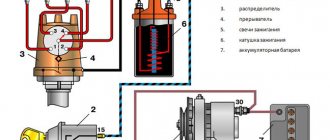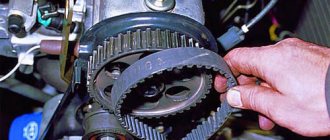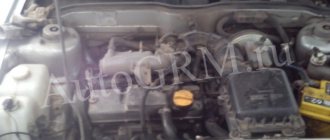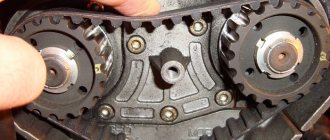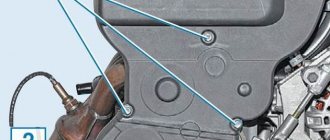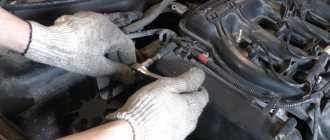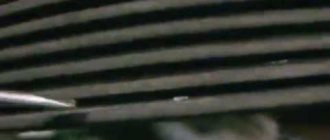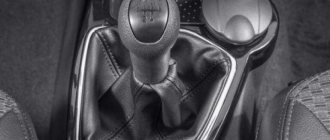How to determine that a car's timing belt has jumped
Like any other car component or part, the timing belt performs certain functions.
It is entrusted with a significant option, and due to the convincingness of its functioning, the operational duration and security of the automotive power plant as a whole is determined. Jumping or slipping of the timing belt is a fairly common phenomenon familiar to many motorists. The belt slips one tooth or several. We are talking about the teeth of the crankshaft or camshaft flywheel. It is clear that such a situation can lead to serious problems.
Signs and symptoms
There are six main signs that the timing belt has jumped.
- The car engine is unstable.
- The engine constantly stalls.
- Noticeable loss of engine power and thrust.
- The engine starts with problems or does not start at all.
- The power plant is stuck.
- The sound of the engine becomes louder - a metallic knock appears.
Most often, it happens that the product jumps one tooth, and because of this, the engine continues to operate, but increases fuel consumption, and there are also interruptions in operation and starting.
If you suspect that several teeth have jumped, you should not restart the engine. In the worst case, this can cause the valves to bend.
Mismatch between crankshaft and camshaft pulley marks
Not every car owner who services his “iron horse” knows where exactly the marks are located on the crankshaft and camshaft pulley. In addition, due to contamination of the power unit, they are often difficult to see. Inconsistency in these parameters can lead to disastrous consequences.
As a result, the timing belt may jump one or more teeth. This will lead to engine malfunctions. In the worst case scenario, the unit will stop starting altogether.
Consequences
The consequences of the timing belt jumping several teeth can be different - from replacing the timing belt itself to repairing the car’s gas distribution mechanism.
The amount of damage depends on whether the engine has recesses for valves in the pistons or not.
A jump can occur while the valves are being lowered to inject fuel or release gases. The pistons are still moving and can hit the valves hard. This will lead to bending of the latter. This situation is similar to a broken timing belt. You can read more about which engines this happens on in this article.
To avoid this situation, it is recommended to do a timely inspection and, if necessary, change the consumable.
Signs of a timing belt that has jumped on the pulley
If the timing belt has jumped, the symptoms may be as follows:
- The engine stalled.
- Unstable motor operation
There may be several reasons why the timing belt may jump Firstly, low tension, and secondly, the presence of oil on the camshaft or crankshaft pulley can cause the belt to slip. Well, and most importantly, a broken timing belt can ultimately lead to damage to the valves of the gas distribution mechanism and internal elements of the internal combustion engine (pistons, connecting rods, etc.)
Broken timing belt while driving
Consequences of malfunctions
Problems in the timing chain drive lead to the following problems:
- A stretched and weakened chain jumps several teeth. As a rule, this happens when the engine starts.
- A chain operating with increased free play often breaks the guide and even “gnaws” a groove in the cylinder head made of aluminum alloy.
- In some brands of cars where a single-row chain is used in power units, it may break.
Note. Chain drives of the timing unit can be single- or double-row. The former are not as reliable and durable as the latter, and often break down after a run of 50-80 thousand km. Double-row drives break extremely rarely, even when the owner of the car does not pay due attention to it.
Double-row chains also break, but very rarely
The consequences of these problems may be as follows:
- The most harmless option is a shift in valve timing due to the chain jumping 1-2 teeth. The engine does not start well and vibrates strongly during operation, and there is a clear loss of power while driving. When you press the accelerator pedal sharply, shots are heard in the intake manifold or exhaust pipe.
- When there is a 3 tooth offset, the engine will no longer start. Another thing is that in practice such situations are rare; a too loose chain skips much more. The result is a piston hitting a valve that opened at the wrong time.
- Due to severe wear or breakage of the damper, the chain drive is weakened even more, causing the consequences described above.
- The damage caused by a broken single-row chain depends on the type of engine and the moment when it happened. If all the valves were closed, then the pistons, which continued to move, would not reach their plates.
This is what the valves look like after meeting the pistons
In power units with 8 valves, encounters with the piston are quite rare due to the technological clearances provided for by the design (except for individual motors). But a 16V engine valve that is open when the chain breaks or jumps almost always receives a blow from the piston. As a result, its stem bends and the valve remains in the open position. In especially severe cases, the consequences are as follows:
- even the valve seat and guide bushing are damaged;
- a through hole appears in the upper part of the piston;
- A dent appears on the plane of the cylinder head near the combustion chamber, which makes it necessary to replace it entirely.
A chain that has jumped or broken while driving makes itself felt by a sharp loss of power or complete engine failure. If you were able to hear a metallic knock, indicating the meeting of the piston and valve, then you should prepare for serious repairs to the power unit.
And this is a piston pierced by a valve plate
Repair cost
The average price for replacing a belt and roller in car services ranges from one to three thousand rubles. The price range is due to the fact that replacing parts on foreign cars costs approximately 2–3 times more than on domestic cars.
If it turns out that you also need to change the engine water cooling pump and the crankshaft oil seal, then the price will increase by another 1 - 1.5 thousand rubles.
Although there is a huge selection of products on the market at different price levels, you should only choose brands recommended by the manufacturer or their high-quality analogues. Using cheap parts can lead to serious damage and expensive repairs.
For example, if the valves are bent as a result of a belt slipping, then almost the entire cylinder head will have to be replaced. Even if the repair is carried out by yourself, the cost of replacing valves, pump, belt, filling oil and antifreeze, and other parts will be at least 10,000 rubles.
The timing belt on a car engine ensures synchronization of the crankshaft with the timing shaft (camshaft).
On engines with a timing belt, breaking it or slipping even one tooth can lead to serious problems, which in the future may lead to a major overhaul of the engine.
Symptoms of malfunction
The main signs that the belt or chain has slipped:
- change in throttle response, power, engine torque;
- increase in the toxicity of exhaust gases, their shade;
- problems when starting the engine;
- a “check engine” error message appears on the dashboard;
- the occurrence of extraneous noise of a non-metallic (for belt drive) and mechanical nature (for both chain and belt drives).
If such signs appear, you should stop driving (start the engine), have the engine diagnosed, or contact a mechanic.
This is how a timing belt works
The timing belt is an important element of the car, so it needs to be serviced promptly. The reasons that lead to its jump are the following:
- Contact of oil or cooling liquid on the belt surface
- Improper use
- Late replacement
- External damage
- Incorrectly placed labels
- Difficult operating conditions
- Low quality spare parts
Of course, these are not all cases due to which the timing belt breaks or jumps. But this can be understood by the following signs.
Gentlemen, has anyone had cases where the belt was not on the marks by 1-2-3 teeth? What are the symptoms and how does it manifest itself in operation? Troits, knocks, rings? Otherwise, there are suspicions after the replacement.
on 3S something like that. With just one tooth, the car started with half a kick, but when you pressed the gas pedal there was a ringing sound in your fingers. My father-in-law's Crown 1G refused to start at all)))
When pressing the gas at idle or while driving? I just get a ringing sound when I move and lightly press the gas.
What's stopping you from removing the covers and checking the marks? If everything is fine, then the electrician needs to set the ignition with a strobe light (in this case, a jumper is placed in the diagnostic connector between Te1 and e1)
both in place and on the move
I really appreciate your participation and admit that I did not provide complete information about the car. You see, I have a 7A-LB engine and the ignition on it is not adjustable. In addition, having worked as a diagnostician myself (albeit for Volvos), I would not have asked a respected forum for help if everything was so simple.)
Wow, this is not my case, I only have it while moving and only with a fully warmed up engine.
I'm waiting for more comments)
By the way, the same canoe after replacing the timing belt, according to the marks, everything is correct, I removed the cover twice, but the ignition stops earlier, I feel it, detonation appears too often. When the heat is not scary, but when frosts start, there may be problems with starting. Even if you fill the gasoline with 98, it still makes a jingling sound. And the tooth here and there won’t be anything terrible, just not big problems. On the jig, I specially threw the chain over one tooth when I went long distance, it ran more fun.
It’s very wrong for you to think so about a mistake of one tooth. Yes, it will start without problems even by 2-3 teeth, but it won’t drive normally even with a mistake of one tooth or it will start guzzling fuel like crazy. Zhiguli is not an example, you know why. And what are the problems, check the installation of the timing belt, there are a lot of books there, everything is simply described there, or ask someone who knows.
By the way, as an option, detonation occurs from severe coking of the CPG, then detonation is practically invincible without drastic measures.
Causes
The timing belt is an important element of the car, so it needs to be serviced promptly. The reasons that lead to its jump are as follows:
Contact of oil or cooling liquid on the belt surface
As soon as traces of technical fluid appear on the product, the belt should be changed immediately. Otherwise, this can lead to slipping through the teeth, sliding off the pulley, and even breaking.
It is a serious mistake when drivers simply clean the dirty surface and continue to use this product.
Practice shows that if liquid gets on the belt, it is completely absorbed into the rubber. It loses its properties and begins to stretch.
Late replacement
Most timing belt manufacturers recommend changing their products approximately every 60 thousand kilometers. However, this figure may vary up or down, depending on the quality of the product.
Improper use
It happens that a product may jump due to errors during its operation. A common example is a weakened roller or tensioner. When the belt tension weakens, there is a possibility of slipping from the pulley grooves. In the opposite situation, if when installing the belt, it is overtightened, this will lead to its breakage.
Slippage can also occur when one of the pulleys has strong play
Therefore, it is very important to monitor the tension level of all parts of the mechanism.
The labels are set incorrectly
Sometimes the jump is not visible outwardly, but the engine does not start well and immediately stalls. This can happen if the marks were knocked down or incorrectly set initially. A shift of even one tooth can cause problems with the motor. If the engine is diesel, it will not start even if there is an error of one tooth.
It is necessary to replace the timing belt in safe places using special tools.
This photo shows that the intake is offset by one tooth clockwise; this is one of the most common mistakes when replacing a belt. To prevent this from happening, you can use special pulley clamps when replacing the timing belt.
External damage
Over time, various cracks and depressions may appear on the surface of the consumable, and the threads of the product may begin to peel off. With heavy loads on the belt, even the smallest defects will develop quite quickly. Therefore, they cannot be eliminated on your own. All you can do is replace it as soon as possible.
Low quality spare parts
There are very cheap “non-original” belts on sale. But don't be fooled by their price. Often the resource of such a product is only enough for 20 thousand kilometers. This is followed by either stretching or breaking.
Difficult operating conditions
Unlike a chain, a belt is very sensitive to high and low temperatures, high humidity and other weather conditions. They affect premature wear of the product. Therefore, more frequent replacement may be required.
P0340 or the timing belt does not hit 1 tooth - logbook Hyundai Getz 1.6 16V 2004 on DRIVE2
The receipt from the purchase was on fire. The owner threw up his hands, saying he blinked when it caught fire, but the car was running, so there was no need to get into it. I immediately thought it was error 340 - an error in the camshaft sensor circuit. The Internet said that it was the Khan sensor, that oil could get into its contact and that’s all, provided that the car was driving. I accidentally came across on some website about other cars in general that the same error was on, but as it turned out, the timing belt did not hit 1 tooth according to the marks. The car is moving, but the gas timing is already off. In contact with the Goetz group, the guru immediately said that if the timing belt is knocked off by 1 tooth, then the valves will knock. In the group of accent guides (their motor), essentially no one answered anything. And the other day, one comrade in the accent group made a note that error 342 was on, he opened the covers, and there on the camshaft pulley the mark did not match by 1 tooth, he set everything again, the error went out and the car froze. Well, I read a lot of manuals (most smart), bought a 22 head and went to the garage with jitters and trembling in my knees) I’ll say right away that there’s nothing complicated, just very scary.
Broken timing belt: causes and consequences
Purpose of the timing belt
The timing belt is an important element responsible for the synchronous and harmonious operation of the camshaft and crankshaft of an internal combustion engine. The part is responsible for the function of timely opening and closing of valves. A fully functional belt turns the camshaft at a strictly specified pace - exactly two times slower than the crankshaft turns. During the rotation of the camshaft, a fuel-air mixture (FA) is supplied to the engine cylinders, and exhaust gases are discharged through the exhaust system. A broken timing belt disrupts the entire normal operating cycle of the power unit, and can lead to serious consequences.
Belt drive was introduced by manufacturers to produce lighter and cheaper automobile engines. At the same time, the noise of the running motor has been significantly reduced. But ordinary consumers paid for everything. Innovations in terms of installing the timing belt have brought problems with maintenance and replacement. The service life of a belt drive is much shorter, and during its operation one should constantly “monitor” its condition and tension.
The designers implied that the timing belt itself must simultaneously have high strength, which is close to the chain, and be completely elastic and wear-resistant. As a result of design efforts, a three-layer timing belt design appeared.
Timing belt replacement interval
Even if the engine’s performance is satisfactory, do not forget to timely check the condition of the timing belt, because it also has a wear limit. You can find out this value from the car’s technical passport, but you can do it much simpler: it is recommended to change the spare part every 50 thousand kilometers. If you bought a used car and don't know when it was last replaced, visually inspect the belt. The appearance of microcracks on the body is the first sign of concern.
However, do not panic, because microcracks do not mean that the assembly will break at the first load. Inside it has a metal base made of thin rods. This allows you to withstand impressive shock loads and not tear for a long period of time. On some models, automakers install impact-resistant belts with reinforced metal cord. Thus, it is possible to extend the service life by approximately 30%.
Causes of timing belt breakage
There are several reasons why the timing belt breaks, and to determine them you need to have at least a little understanding of the structure of the power unit. Often, drivers encounter this problem after replacing a belt or repairing the gas distribution mechanism, which is associated with replacing valve guides.
Causes of timing belt breakage
The timing belt is one of the main elements of a car that needs to be serviced promptly and efficiently. In this case, the reasons for a broken timing belt may be the following:
Untimely replacement of the unit. As a rule, the manufacturer recommends replacing the product after 60-70 thousand kilometers. But recommendations may differ - each manufacturer can indicate its own time parameters, which are often more or less than the period we mentioned.
Incorrect operation. The belt can break not only due to natural aging, but due to errors in the operation of the entire unit. For example, if the tensioners, rollers or pump jam while driving, the resulting impulse can lead to a rupture of the timing belt. It looks strong and doesn't tear. When the rotation of the crankshaft reaches 5-6 thousand revolutions, any sudden impulse can lead to irreparable consequences. Particular attention should be paid to belt tension. Often the cause of rupture is its constriction. On the other hand, weakening the tension can lead to a problem with similar consequences - the belt jumping off the pulley grooves. There is a high probability of the same situation if there is strong play in one of the pulleys. That is why it is so important to promptly check the timing belt tension and the condition of all system elements.
Oil getting on the surface. When the first traces of oil or coolant appear on the timing belt, the product must be replaced. Otherwise, the entire gas distribution mechanism may not operate efficiently, the belt may slip, jump off the pulley, or even break. Many car enthusiasts make a big mistake - they simply wipe off the existing dirt with a rag and continue to use the car.
As practice shows, once technical liquid gets on the belt texture, it is no longer possible to remove it. Rubber literally absorbs oil and loses its quality. You can only save yourself by replacing it.
Low quality product. When purchasing a timing belt on the market “cheaply,” be prepared for “surprises” during operation. Please note that saving in this matter will inevitably lead to even greater costs in the future. If you are going to buy parts for a car, they must be original. In this case, you will be absolutely sure of their quality and declared service life. Service station technicians are well aware of situations where, because of a few hundred rubles in savings, car owners spent tens of thousands on repairs. This is not surprising, because a low-quality timing belt may not last even 20 thousand kilometers. Believe me, driving and expecting the belt to hold up at any time is not the best pleasure.
External damage. Due to natural wear and tear or poor quality, various defects may appear on the belt, for example, indentations, cracks, peeling of threads at the end of the product, and so on. Such defects cannot and cannot be eliminated. The only solution in this case is to install a new belt. You shouldn’t ignore the problem either, because at maximum load even a small defect will develop very quickly and cause the belt to break. Subsequently, you can blame yourself for a long time for being slow, but you can’t return the past.
How to correctly set marks during the process of replacing/installing a belt on a “nine”
The timing belt on cars with front-wheel drive is carried out using a toothed belt. Each successive replacement of the AvtoVAZ belt is recommended after 65,000 miles. In addition to replacing the element itself, it is also recommended to change the roller.
The algorithm for replacing the timing belt is as follows:
- First of all, a new belt and roller are purchased (it is advisable that both elements are recommended by the car manufacturer);
- The car is placed on a level surface;
- The battery is de-energized (due to the exception of a short circuit during the work process);
- The car is secured with special anti-rollback stops;
- The protective cover is removed from the timing system;
- The power unit is set according to the marks.
How the marks are set
It is important to be able to set the marks so that in the front part of the engine the mark on the camshaft wheel coincides with the upper boss on the belt cover. As for the second mark, it is connected to the clutch cover hatch
It is located under the distributor. This hatch is protected by a special rubber plug, which must be pulled out. And if the marks are set correctly, you should check the mark on the hatch: if in the triangle of the hatch you can see a mark that coincides with the end of the flywheel, then everything is correct
As for the second mark, it is connected to the clutch cover hatch. It is located under the distributor. This hatch is protected by a special rubber plug, which must be pulled out. And if the marks are set correctly, you should check the mark on the hatch: if in the triangle of the hatch you can see a mark that coincides with the end of the flywheel, then everything is correct.
The belt replacement procedure continues:
- The right wheel of the VAZ is dismantled (before this, a reliable support must be placed under the car body, for example, an empty 20-liter container for fuel on the edge);
- The protective type belly is disassembled to gain access to the shaft wheel and belt, respectively;
- The tension of the generator belt is weakened by moving it in the direction of the BC;
- The belt is dismantled;
- The bolt securing the pulley is unscrewed using special tools (mount, head, etc.).
- The tension roller clamps are loosened.
- The timing belt is removed along with the roller.
- A new roller is installed in place, and a new timing belt is installed.
Installing a timing belt is a rather difficult task. First of all, it is recommended to try to insert the belt on the right side of the “branch”.
Then, as soon as the belt is in place, you should tighten it with the tension roller step, and then fix it in this position.
At the final stage of work, check the identity of the marks again. For example, while the crankshaft flywheel is removed, you can additionally diagnose the mark on the crankshaft by comparing the mark on the shaft sprocket and the cutout on the oil pump boss. If the marks are not in place, you will have to repeat the installation again. This is done until the marks match. After this, the crankshaft is turned two turns, and compatibility is re-diagnosed. If the marks match, you need to proceed to assembly.
After everything is assembled, the power unit starts. If a characteristic hum appears, which should not be there, this clearly indicates that the belt is overtightened. You will have to re-adjust.
After closing the belt with the protective cover, it is recommended to check the belt for snagging, and the power unit for clean operation. If knocking and noise does not disappear, it is recommended to install the cover with bolts, thereby tightening it into the desired position.
Broken timing belt: causes and consequences
Purpose of the timing belt
The timing belt is an important element responsible for the synchronous and harmonious operation of the camshaft and crankshaft of an internal combustion engine. The part is responsible for the function of timely opening and closing of valves. A fully functional belt turns the camshaft at a strictly specified pace - exactly two times slower than the crankshaft turns. During the rotation of the camshaft, a fuel-air mixture (FA) is supplied to the engine cylinders, and exhaust gases are discharged through the exhaust system. A broken timing belt disrupts the entire normal operating cycle of the power unit, and can lead to serious consequences.
Belt drive was introduced by manufacturers to produce lighter and cheaper automobile engines. At the same time, the noise of the running motor has been significantly reduced. But ordinary consumers paid for everything. Innovations in terms of installing the timing belt have brought problems with maintenance and replacement. The service life of a belt drive is much shorter, and during its operation one should constantly “monitor” its condition and tension.
The designers implied that the timing belt itself must simultaneously have high strength, which is close to the chain, and be completely elastic and wear-resistant. As a result of design efforts, a three-layer timing belt design appeared.
Timing belt replacement interval
Even if the engine’s performance is satisfactory, do not forget to timely check the condition of the timing belt, because it also has a wear limit. You can find out this value from the car’s technical passport, but you can do it much simpler: it is recommended to change the spare part every 50 thousand kilometers. If you bought a used car and don't know when it was last replaced, visually inspect the belt. The appearance of microcracks on the body is the first sign of concern.
However, do not panic, because microcracks do not mean that the assembly will break at the first load. Inside it has a metal base made of thin rods. This allows you to withstand impressive shock loads and not tear for a long period of time. On some models, automakers install impact-resistant belts with reinforced metal cord. Thus, it is possible to extend the service life by approximately 30%.
Causes of timing belt breakage
There are several reasons why the timing belt breaks, and to determine them you need to have at least a little understanding of the structure of the power unit. Often, drivers encounter this problem after replacing a belt or repairing the gas distribution mechanism, which is associated with replacing valve guides.
Causes of timing belt breakage
The timing belt is one of the main elements of a car that needs to be serviced promptly and efficiently. In this case, the reasons for a broken timing belt may be the following:
Untimely replacement of the unit. As a rule, the manufacturer recommends replacing the product after 60-70 thousand kilometers. But recommendations may differ - each manufacturer can indicate its own time parameters, which are often more or less than the period we mentioned.
Causes of belt and timing chain jumping
The main reasons for timing belt skipping are:
- natural wear of the belt during operation;
- abrasion of teeth as a result of misalignment of the rollers;
- increased resistance to movement in the event of a malfunction in the gas distribution system;
- foreign objects getting into the belt drive;
- pulley wear;
- stretching of a low-quality belt;
- overheating of the power unit;
- Tensioner malfunction.
Jumping of chain links (links) is less likely, but the consequences of such a malfunction are more serious. Causes of chain jumping:
- stretching during operation;
- chain damper malfunction;
- natural chain wear;
- temporary jamming of the gas distribution mechanism;
- overheating of the power unit;
- foreign objects entering the area of chain movement.
This is interesting: Speakers for Honda Accord 7: dimensions and installation
